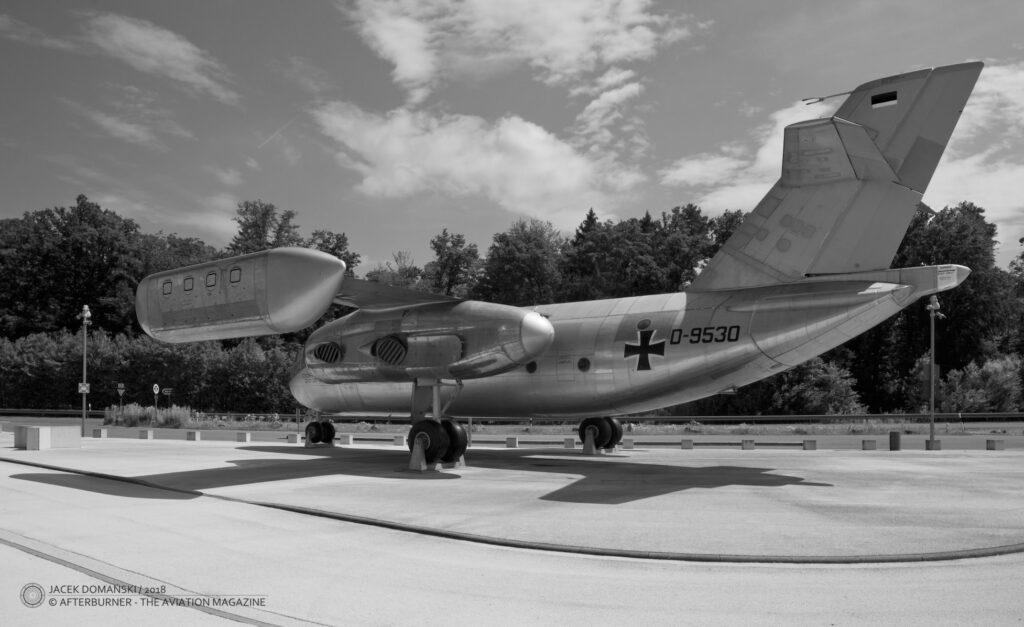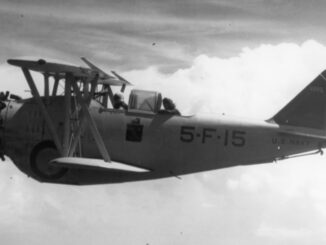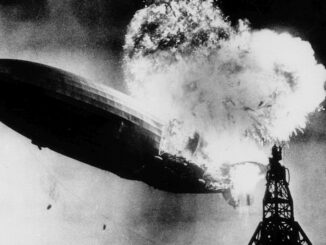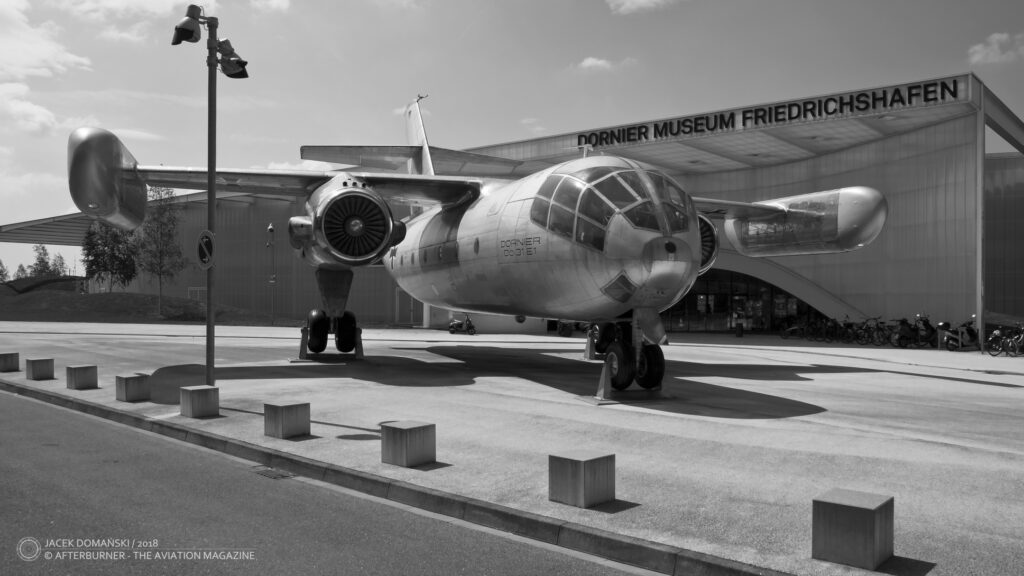 On 10th February 1967, the prototype of West German vertical take-off and landing (VTOL), jet-powered transport aircraft, performed its first flight.
On 10th February 1967, the prototype of West German vertical take-off and landing (VTOL), jet-powered transport aircraft, performed its first flight.
In the 1960s and 1970s, development of vertical or short take-off and landing, jet-powered aircraft was launched in several countries. Those designs included several, sometimes very ambitious, ideas and represented various approach to the concept. Starting from the most future-looking, full VTOL aeroplanes (Yakovlev Yak-36 and Yak-38, Republic Aviation AP-100, Dassault Mirage IIIV, EWR VJ 101 or Hawker P.1127), through the conception of short take-off and vertical landing / STOVL aircraft (Ryan XV-5 Vertifan, Armstrong Whitworth AW.681) to more conventionally-looking jets, featuring the short take-off and landing / STOL capabilities (Boeing YC-14, McDonnel Douglas YC-15).
One of the ideas behind that development was the desire to create a versatile combat aircraft with full VTOL capabilities, able to be used as an interceptor or fighter-bomber jet. Absolutely nothing new, as such idea is as old as the heavier-than-air aeroplane and was put into effect during the Second World War (Bachem Ba 349 Natter).
That idea was fully supported by NATO, as the Alliance authorities were afraid its airfields would be destroyed by the Warsaw Pact at the beginning of potential conflict. Therefore, in the early 1960s, NATO Basic Military Requirement 3 was issued, providing specifications for the expected supersonic fighter (NBMR-3a) and subsonic fighter-bomber (NBMR-3b). They were then followed by NBMR-4, the specification for V/STOL transport aeroplane intended to support the combat aircraft.

Although the abovementioned developments resulted in several interesting designs, only two of them achieved the operational status. Both of them were multirole deck fighters – the Hawker P.1127, that finally evaluated into Hawker Siddeley Harrier, and the Yak-38. However, the latter was manufactured only in small number and reportedly plagued with technical issues.
Among these developments of the 1960s there was also the Dornier Do 31, the aircraft that was created following the NBMR-4 specification. At that time, the West Germany was already working on its VTOL fighter concept, so it seemed the transport aeroplane of similar characteristics would be needed soon.
The programme was officially launched in February of 1962 and the Dornier company was assigned the task to lead the project. Since the end of the 1950s, Dornier´s design team was already working on some V/STOL studies that were now implemented into the new aeroplane. In addition, the company asked several foreign companies that also worked on similar projects – such as Bristol Siddeley – to cooperate on the Do 31 programme.
An interesting fact is that, to support the design process, Dornier built a dedicated hybrid computer that combined features of analog and digital computers. Known as DO-960, the computer was necessary for calculating characteristics of the vertical take-off, the task not feasible for then existing digital computers.
In 1964, three prototypes of the Do 31 were built. Each of them was intended for different part of the test programme – the E1 was intended to evaluate the prototype during horizontal flight, the E2 was for static testing of the airframe, and finally the E3 was the one to perform vertical take-off and landings.
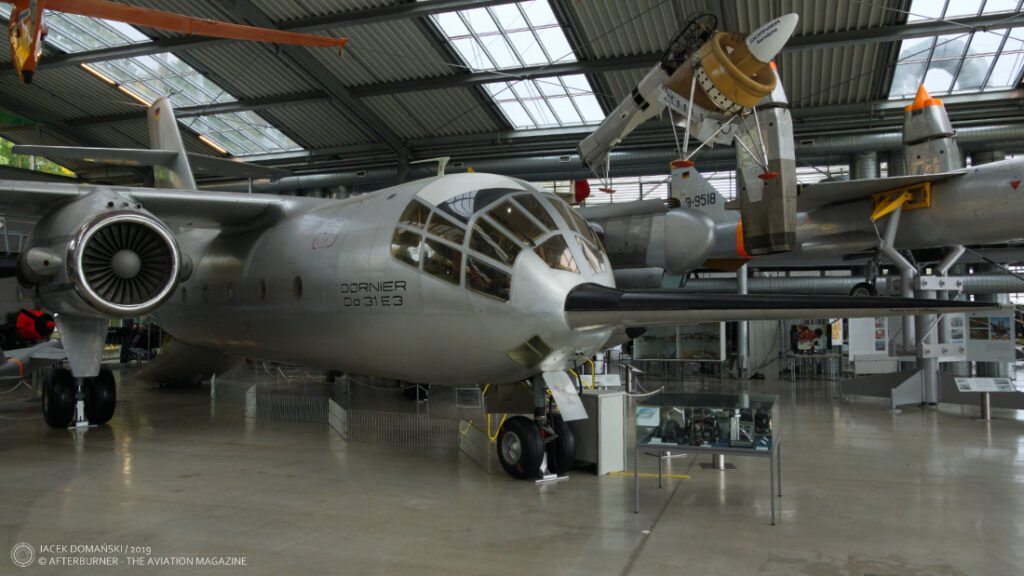
The Do 31 was powered by two sets of engines. Two Bristol Siddeley Pegasus, vectored-thrust turbofan engines were mounted under the wings and used during vertical flight. In addition, the aircraft was equipped with eight Rolls-Royce RB162 turbojet lift engines, mounted at the end of its wings in two outer nacelles.
On 10th February 1967, the E1 prototype performed its first, vertical flight. It was followed by the first hovering, performed by the E3 in December of the same year. However, at the time the Do 31 completed its maiden flight, NATO abandoned the idea of VTOL combat aircraft and all aforementioned specifications were officially withdrawn.
Nevertheless, the West Germany decided to continue with such developments. Evaluation and test flights of the Do 31 lasted until the spring of 1970. The aircraft was often presented to government authorities and general public, including its performance at the 1969 Paris Air Show.
Regrettably, at the beginning of 1970, the Luftwaffe finally abandoned all its combat VTOL aircraft programmes. Similarly to other comparable developments, those projects finally turned out to be too expensive and still experienced technical and logistical issues. For a while, Dornier was trying to advertise its VTOL aircraft and was looking for international customers. Unfortunately, without any success and finally the programme was officially closed in April of 1970.
The Dornier Do 31 was, and currently still is, the only jet-powered transport aircraft with VTOL capabilities that ever flew. Both E1 and E3 prototypes survived until today and are exhibited respectively at Dornier Museum Friedrichshafen and Deutsches Museum Flugwerft Schleissheim in Munich.
